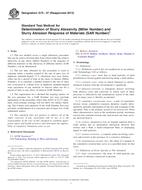Potřebujeme váš souhlas k využití jednotlivých dat, aby se vám mimo jiné mohly ukazovat informace týkající se vašich zájmů. Souhlas udělíte kliknutím na tlačítko „OK“.
ASTM G75-07(2013)
Standard Test Method for Determination of Slurry Abrasivity (Miller Number) and Slurry Abrasion Response of Materials (SAR Number)
Automaticky přeložený název:
Standardní zkušební metoda pro stanovení kalu abrazivity (Miller Number) a kalů otěru odezvy materiálů (SAR Number)
NORMA vydána dne 15.11.2013
Informace o normě:
Označení normy: ASTM G75-07(2013)
Poznámka: NEPLATNÁ
Datum vydání normy: 15.11.2013
Kód zboží: NS-57809
Počet stran: 21
Přibližná hmotnost: 63 g (0.14 liber)
Země: Americká technická norma
Kategorie: Technické normy ASTM
Anotace textu normy ASTM G75-07(2013) :
Keywords:
Miller Number, SAR Number, slurry abrasivity, slurry material wear, ICS Number Code 17.040.20 (Properties of surfaces)
Doplňující informace
| Significance and Use | ||||
|
5.1 The Miller Number5 is an index of the relative abrasivity of slurries. Its primary purpose is to rank the abrasivity of slurries in terms of the wear of a standard reference material. The wear damage on the standard wear block is worse as the Miller Number gets higher. 5.2 The SAR Number is an index of the relative abrasion response of materials as tested in any particular slurry of interest. The SAR Number is a generalized form of the Miller Number applicable to materials other than the reference material used for the Miller Number determination. A major purpose is to rank construction materials for use in a system for pumping and fluid handling equipment for a particular slurry. It can also be used to rank the abrasivity of various slurries against any selected construction material other than the reference material specified for a Miller Number determination. The slurry damage on the specimen of material being tested is worse as the SAR Number gets higher. 5.3 Experience has shown that slurries with a Miller Number or a SAR Number of approximately 50 or lower can be pumped with minor abrasive damage to the system. Above a number of 50, precautions must be observed and greater damage from abrasion is to be expected. Accordingly, the Miller Number and the SAR Number provide information about the slurry or the material that may be useful in the selection of pumps and other equipment and to predict the life expectancy of liquid-end parts of the pumps involved. 5.4 The SAR Number can be used to determine the most suitable materials for certain slurry systems. |
||||
| 1. Scope | ||||
|
1.1 This test method covers a single laboratory procedure that can be used to develop data from which either the relative abrasivity of any slurry (Miller Number) or the response of different materials to the abrasivity of different slurries (SAR Number), can be determined. 1.2 The test data obtained by this procedure is used to calculate either a number related to the rate of mass loss of duplicate standard-shaped 27 % chromium iron wear blocks when run for a period of time in the slurry of interest (Miller Number), or to calculate a number related to the rate of mass loss (converted to volume loss) of duplicate standard-shaped wear specimens of any material of interest when run for a period of time in any slurry of interest (SAR Number). 1.3 The requirement for a finished flat wearing surface on the test specimen for a SAR Number test may preclude application of the procedure where thin (0.051 to 0.127-mm), hard, wear-resistant coatings will not allow for surface finishing. The 6 hours total duration of the SAR Number Test may not allow establishment of a consistent rate-of-mass-loss of the unfinished surface. 1.4 This standard does not purport to address all of the safety concerns, if any, associated with its use. It is the responsibility of the user of this standard to establish appropriate safety and health practices and determine the applicability of regulatory limitations prior to use. |
||||
| 2. Referenced Documents | ||||
|
Doporučujeme:
Aktualizace zákonů
Chcete mít jistotu o platnosti užívaných předpisů?
Nabízíme Vám řešení, abyste mohli používat stále platné (aktuální) legislativní předpisy.
Chcete vědět více informací? Podívejte se na tuto stránku.




 Cookies
Cookies
